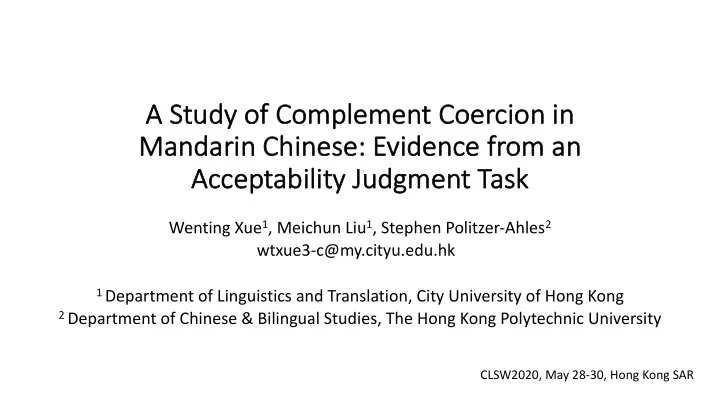

A Study of Complement Coerci cion in Mandarin Chinese: Evidence ce from an Acce cceptability Judgment Task Wenting Xue 1 , Meichun Liu 1 , Stephen Politzer-Ahles 2 wtxue3-c@my.cityu.edu.hk 1 Department of Linguistics and Translation, City University of Hong Kong 2 Department of Chinese & Bilingual Studies, The Hong Kong Polytechnic University CLSW2020, May 28-30, Hong Kong SAR
Complement Coercion Complement coercion (Jackendoff, 1997; Pustejovsky, 1991; 1995) refers to a linguistic phenomenon in which certain verbs (e.g., begin ), which semantically select for an event-denoting complement (as reading/to read the book in 1a), can combine with an entity-denoting complement (as the book in 1b). The entity NP the book in (1b) is supposed to be coerced a relevant event information. Example: 1. (a) Mary began reading/to read the book . (b) Mary began the book .
Complement Coercion in Mandarin Complement coercion has been studied extensively in English and other Germanic languages, not much, however, is known about the relevant linguistic phenomenon in Mandarin Chinese. Presumption: Complement coercion may not exist in Mandarin (Lin & Liu, 2005) Example: 2. * (a) 张三开始⼀丁本书 ‘John began a book .’ (b) 张三开始读 ⼀丁本书 ‘John began reading/to read a book .’
Evidence of Complement Coercion in Mandarin Studies with linguistic analyses : e.g., Liu (2005) from the perspective of Constructional Grammar, Song (2015) from Generative Lexicon Studies with corpus-based approach : e.g., Lin et al. (2009) Example: 3. [ 赶 GAN+NP] (Liu, 2005) (a) 赶 报告 ‘rush (to finish writing) a written report’ (b) 赶 写 报告 ‘rush to write a written report’ Although complement coercion in Mandarin has drawn attention of some linguists, little experimental evidence has been provided.
Purpose of Current Study The current study examined the acceptability of Mandarin sentences with complement coercion configuration (i.e., Event-selecting Verb + Entity- denoting NP). The acceptability rating of the coercion sentences was compared with that of non-coercion equivalents.
Method: Materials 22 triplets of stimuli (an example set is shown in Table 1) with an entity- denoting complement preceded by three verb types: a) Event-selecting verbs (i.e., EventVs), which semantically select for an event- denoting complement, were five aspectual verbs, e.g., 开始 ‘start/begin’; b) Preferred verbs (i.e., PreferredVs), which denote a preferred interpretation to the expressions with the EventVs, were determined with a sentence completion task; c) Non-preferred verbs (i.e., Non-preferredVs), which denote a non-preferred but plausible interpretation to the expressions with the EventVs, were determined with the same sentence completion task;
PreferredV and Non-preferredVs were determined by asking a group of Mandarin speakers to fill in the blank with a verb to coercion sentences, like 翻译员完成 ____ 这篇文章 ‘The translator finished__the article’). The most frequently used verb was selected as a preferred verb, and the least frequently used verb was selected as a non-preferred verb.
Method: Participants, Procedures, Data Analysis Participants: 60 native Mandarin speakers Procedures: The experimental stimuli were divided into three lists with Latin Square Design. Participants were randomly distributed to one list to rate the acceptability of the stimuli with a scale of 6 (1 = completely unacceptable; 6 = completely acceptable). Data analysis: One-Way ANOVA
Results: Mean Acceptability Ratings 1) All means were higher than the midpoint (i.e., 3.5) of the scale; 2) EventVs (i.e., coercion) received numerically lower means than Non- preferredVs and PreferredVs counterparts (i.e., non-coercion); 3) No statistically significant difference was found among the conditions.
Discussions and Further Research Discussion: 1) Complement coercion sentences were rated with relatively higher acceptability scores (higher than the midpoint of the scale), which indicated that the coercion sentences were generally acceptable to Mandarin speakers; 2) The complement coercion expressions were less acceptable than their non-coercion counterparts, i.e., preferred and non-preferred ones; 3) The lack of a significant acceptability difference between the coercion and non-coercion conditions may be due to: a) the inclusion of a biased subject with which the underspecified event, associated with the complement of the coercion sentences, could be retrieved easily, and thus the sentences were rated with higher acceptability scores; b) the inclusion of few not that natural expressions in the non-coercion conditions, which may lead to lower acceptability scores for the conditions. Further Research: 4) A condition with unambiguously unacceptable sentences as baseline can be included to test whether complement coercion sentences are significantly more acceptable.
Selected References Jackendoff, R. (1997). The architecture of the language faculty . Cambridge, MA: MIT Press. Lin, S. Y., Hsieh, S. K., & Huang, Y. J. (2009). Exploring Chinese type coercion: A web-as-corpus study. In The 5th International Conference on Generative Approaches to the Lexicon . Lin, T. H. J., & Liu, C. Y. C. (2005). Coercion, event structure, and syntax. Nanzan Linguistics , 2 , 9-31. Liu, M. C. (2005). Lexical information and beyond: MEANING coercion and constructional inference of the mandarin verb gan. Journal of Chinese Linguistics , 310-332. Pustejovsky, J. (1991). The generative lexicon. Computational linguistics, 17 (4), 409-441. Pustejovsky, J. (1995). The generative lexicon . MIT Press, Cambridge, MA. Song, Z. Y. (2015). The generative lexicon and event coercion in Mandarin Chinese (in Chinese). Beijing, Beijing Daxue Press. 宋作 艳 . (2015). ⽣甠成词库理痢论与汉语事件强迫现象研
Recommend
More recommend